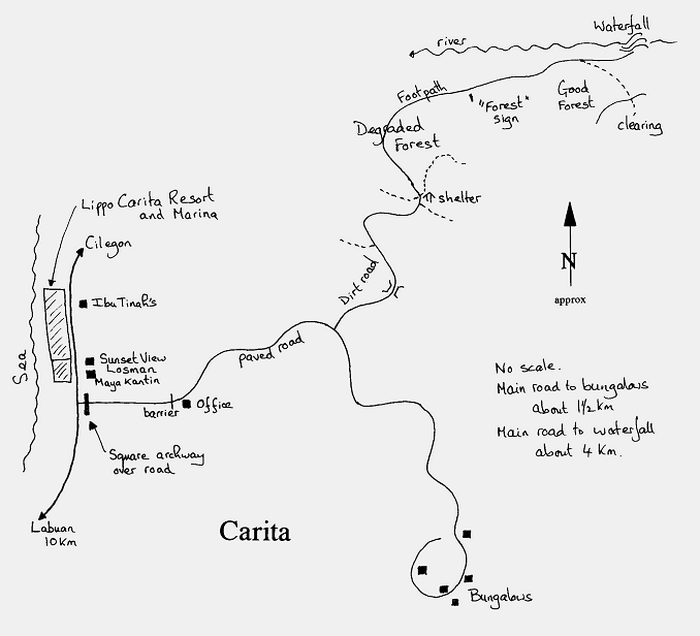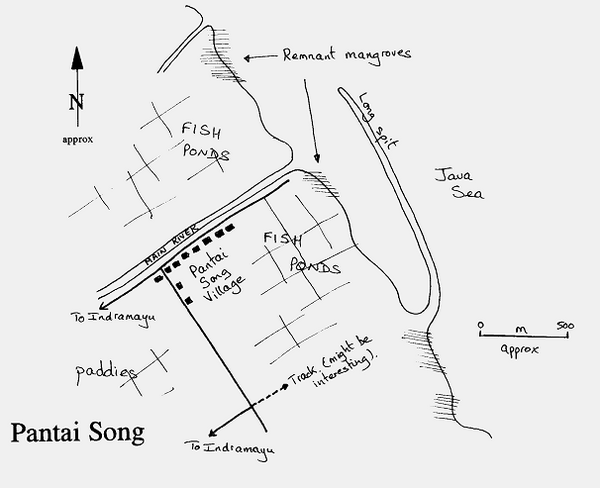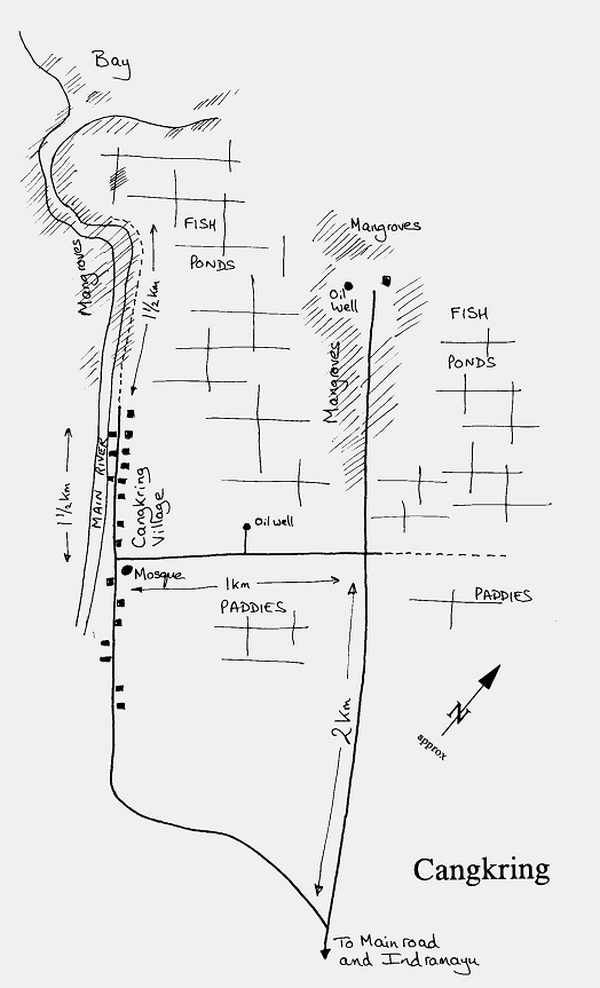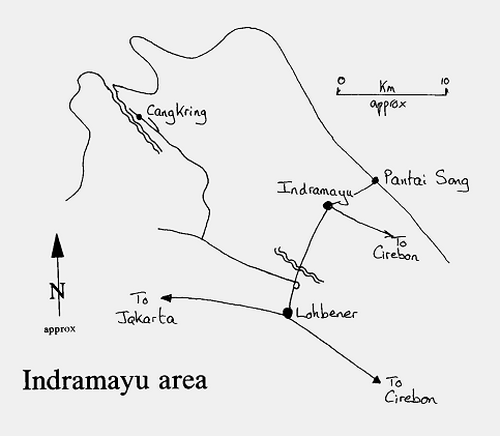Section 1 - Introduction, logistics, itinerary and general information.
Section 2 - Birding sites (Java - Bogor Botanical Garden).
Section 3 - Birding sites (Java - Gunung Gede and Cibodas).
Section 4 - Birding sites (Java - Carita, Indramayu, Pantai Song and Cangkring).
Section 5 - Birding sites (Java - Baluran, Pangandaran and Segara Anakan).
Section 6 - Birding sites (Bali - Gilimanuk and Bali Barat).
Section 7 - Birding sites (Bali - Bedugal, Ubud and Sanur).
Section 8 - Annotated checklist.
Carita
Carita (pronounced Charita) is a popular beach resort on the west coast of Java. A small area of degraded, with an even smaller area of primary, forest is accessible via a track leading to a rather unexciting waterfall which poses as a tourist attraction. For birders the main attraction is a small population of White-breasted Babbler, though recent sightings imply falling numbers, probably due to increased clearance for plantations. For myself I had a poor two days; the birding being washed-out by continuous rain, together with a landslide on the trail to the waterfall.
Carita is accessible by bus from either Jakarta or Bogor. From Jakarta take a bus to Cilegon and then a bemo travelling toward Labuan which will go directly through Carita. From Bogor I took a bemo to Rangkasbitung (3,000 Rp), followed by a bus to Labuan (3,000 Rp), and then a bemo the ten kilometres north to Carita (500 Rp). At the bus station at Labuan you will be surrounded by rickshaw and donkey cart drivers who claim that there is no motorised transport to Carita. All this is, of course, horse manure, as a short walk across the road reveals many bemos ploughing the route northward toward Cilegon. Everyone assumes you will want to be dropped at one of the numerous beach hotels between Labuan and Carita, so ask for the Lippo Carita Resort, which is directly opposite the entrance to the waterfall. Accommodation is available at several losman and homestays, and I stayed at the Sunset View Losman for 20,000 Rp per night. They also had cheaper rooms for 15,000 Rp (all the rooms seemed to leak - though the weather was extreme). Others have stayed at Hostel Rakata (30,000 Rp/double) and Ibu Tinah's, where it is also possible to eat and which has a reasonable stock of basic provisions. As Ibu Tinah's was overflowing with Australian and German beach tourists I ate at the Maya Kantin next door to the Sunset View Losman, which was empty.

The waterfall and forest are accessed by the driveable track starting just a hundred metres from the Sunset View Losman in the direction of Labuan. The start of the track is marked with a "square" archway and after 200 metres a barrier across the road where you are required to pay a 1,000 Rp entrance fee. To the left here is a fenced, cultivated area, which is often referred to as the "deer park", though I saw no indication of any. Javan Kingfisher has been seen here. A couple of hundred metres after the barrier the road swings right leading to some bungalows with the waterfall track off the left. This dirt track passes through degraded forest, and is driveable (by 4x4 in wet) for a couple of kilometres as far as a wooden shelter. From here several trails radiate out into plantations and cut-over forest and might be interesting for second growth and other species of the tangled undergrowth. From the shelter the main trail narrows and eventually leads to relatively undisturbed primary forest, the start of which is marked with a large sign about "maintaining the natural forest". From here it is about a kilometre to the waterfall and it is along this stretch that is the best place to try for the White-breasted Babbler. The total distance from the main road to the waterfall is about four kilometres. Birding can be good anywhere along the dirt track. Other than the babbler, this area is also a good place for Javan Sunbird, Grey-cheeked Tit-Babbler (common) and Black-banded Barbet. Javan Kingfisher is sometimes found nearer the waterfall end of the trail, and Javan Hawk-Eagle does occur. Night birding is worthwhile, as both Javan Owlet and Javan Frogmouth are occasionally found along the main dirt track or the road to the bungalows.
Species recorded from Carita:
Frigatebird spp. 1(r) |
Common Iora (c) Black-naped Oriole (o) Black-throated Oriole (r) Lesser Cuckooshrike (r) Pied Triller (r) Small Minivet (r) Scarlet Minivet 3(c) Black-winged Flycatcher-shrike (c) Asian Fairy-Bluebird (o) Greater Green Leafbird (o) Blue-winged Leafbird (o) Blue Whistling-Thrush (r) Chestnut-capped Thrush (r) Fulvous-chested Jungle-Flycatcher (o) Asian Brown Flycatcher 1(r) Oriental Magpie-Robin (c) Sunda Forktail (r) Velvet-fronted Nuthatch 3(c) Pacific Swallow (o) Eastern Red-rumped Swallow (o) Black-headed Bulbul (c) Black-crested Bulbul (o) Sooty-headed Bulbul (o) Yellow-vented Bulbul (c) Olive-winged Bulbul (o) Cream-vented Bulbul (r) Red-eyed Bulbul (o) Grey-cheeked Bulbul 2(c) Sunda Bulbul (r) Sangkar White-eye (c) Zitting Cisticola (o) Bar-winged Prinia (c) Plain Prinia 1(o) Common Tailorbird (o) Ashy Tailorbird (r) Horsfield's Babbler (c) Temminck's Babbler (r) Javan Black-capped Babbler 2(c) Scaly-crowned Babbler (o) Large Wren-Babbler (o) White-breasted Babbler (o) Grey-cheeked Tit-Babbler 1(c) Great Tit 2(c) Eurasian Tree-Sparrow (o) Javan Munia (c) Orange-bellied Flowerpecker (c) Plain Flowerpecker (o) Scarlet-headed Sunbird (r) Plain-throated Sunbird (c) Ruby-cheeked Sunbird 2(c) Javan Sunbird 1(c) Little Spiderhunter (o) Grey-breasted Spiderhunter (o) |
Indramayu and Pantai Song
Indramayu, on the north coast, 160 kilometres east of Jakarta, makes a good base to cover a short trip to Pantai Song and Cangkring (next site). A visit to Pantai Song, a sleepy fishing village on the coast just a few kilometres northeast of Indramayu, provides a good opportunity for finding Javan Plover and Javan White-eye, both of which have a rather patchy and restricted range, not usually seen on the standard birding route of Java and Bali.
To get to Indramayu, take one of the numerous buses ploughing the northern highway (Eg. Jakarta to/from Cirebon), and get off at Lohbener on the main road. From there take an ojek to Indramayu town (1,000 Rp). The best place to stay appears to be the Wisma Rini in town, but this was full, so I stayed at the Hotel Wiwa Perkasa (22,000 Rp), which was fine. I noted numerous other hotels, losman and homestays scattered around the town.
|
To get to the beach at Pantai Song, 3-4 kilometres from town, take an ojek or a rickshaw. This cost me Rp 4,000, but should not be more than 2,000 Rp I would guess. It's also possible to walk, as the paddies en route provide good birding with a host of possibilities including herons and crakes. Milky Stork is regularly seen. I had 30 Javan Plover and a group of six Oriental Plover on a recently drained fish pond just before the village. The Javan White-eye should be searched for in the ever-decreasing remnant mangroves along the coast. Once at the village, walk to the beach, where it is possible to either walk south along the beach or across the fish ponds. I saw one small group of Javan White-eye in the tiny remnant patch of mangroves just at the start of the beach. |
A better area of mangroves can be seen to the north of the river, though I did not have time to explore them. It would seem reasonable to presume that Sunda Coucal should occur in the better areas of mangrove. Previously a footbridge spanned the narrow river in the village, though at the time of my visit it was not present (rainy season - high water?). However, it would be simple to ask one of the many boatmen for a lift across. Javan Plover can sometimes be seen around the fish ponds near the beach. During my visit there were several small plovers feeding on the long sand bar stretching out from the coast. Unfortunately these are too distant to identify, and it would be necessary to walk down the coast and along the spit to obtain better views. This site got hot very early. Low-lying, open with almost no shade - early morning and late afternoon almost exclusively. Asian Golden Weaver formerly bred in the area, but appears to have been trapped out.

Species recorded from Pantai Song: This list is based on insufficient information. More species, especially among the waterbirds and waders, could be expected.
Sunda Teal 3(o) |
Savanna Nightjar (c) Feral Pigeon 3(c) Cave Swiftlet c(c) Edible-nest Swiftlet 10(c) House Swift (o) Small Blue Kingfisher 1(c) Sacred Kingfisher (o) Golden-bellied Gerygone (r) Pied Fantail (c) Black Drongo (o) White-breasted Woodswallow (o) Barn Swallow 4(c) Yellow-vented Bulbul (c) Javan White-eye 8(o) Zitting Cisticola 4(c) Plain Prinia 10(o) Clamorous Reed-Warbler (o) Ashy Tailorbird 10(c) Scaly-breasted Munia 10(c) Asian Golden Weaver (r) Ornate Sumbird (o) |
Cangkring
The northern coastal village of Cangkring is an excellent spot to find two of the more elusive of Indonesia's birds - Javan White-Eye, a species restricted to northwest Java and southern Borneo, and Sunda Coucal, a Javan endemic. Although the Coucal is widespread on Java it has a highly localised and restricted range, due to the massive clearance of coastal mangroves for fish ponds, and is now endangered. Cangkring, a sizable fishing village, lies c30-35 kilometres northwest of Indramayu. As the village has no accommodation and only a few basic tokos, it is better to make a day trip from Indramayu. Few foreigners are seen here, and as you walk along the main street in the village you will be the talk of the town for the day.
To get to Cangkring it is necessary to hire an ojek from Indramayu or the main road at Lohbener which costs about 6,000 Rp (depending on your bargaining skills), and takes around 40 minutes. It's useful to have a copy of the overview map with you, as there is apparently more than one "Cangkring". Several drivers discussed the whereabouts of Cangkring when I asked for it, but a drawing of the area soon cleared up the confusion. I also had problems finding return transport to Indramayu after dark, so I would recommend arranging with your driver to return to collect you.
Two areas are worth exploring, and it would almost certainly be worthwhile to hire a boat and explore the mangroves on the other side of the river, which are more extensive. The easiest access is simply to walk into the fish ponds at the northwestern end of the village and bird the mangrove remnants along the edge of the river. After rains the banks can be very muddy and slippery, so expect to get filthy, and watch your step as some of the banks can collapse.

A second area of degraded mangrove remnants can be found along the gravel road one kilometre to the east which leads to an abandoned oil well. Coucal spp. were heard in both areas, though none was seen. Although these were probably Sunda Coucal, Lesser Coucal is presumed to occur in the area (though none listed - lack of data.) As might be expected getting into the mangroves is rather difficult.
Despite supposedly being "common" in the area, Javan White-eye was difficult to find. Two small groups were eventually found in mangrove edge about 1.5 kilometres north of the village at the point where the river curves to the west. A word of warning for Cangkring - the mosquitos are ubiquitous in the mangroves (at least at the time I was there). Use liberal amounts of insect repellent and wear long sleeves and trousers. As at Pantai Song conditions in the field heated-up early, with little available shade.
Species recorded from Cangkring: This list is based on insufficient data. More species, especially among the waterbirds and waders, could be expected.
Little Cormorant 1(o) |
Pacific Swift 10(o) |
Section 1 - Introduction, logistics, itinerary and general information.
Section 2 - Birding sites (Java - Bogor Botanical Garden).
Section 3 - Birding sites (Java - Gunung Gede and Cibodas).
Section 4 - Birding sites (Java - Carita, Indramayu, Pantai Song and Cangkring).
Section 5 - Birding sites (Java - Baluran, Pangandaran and Segara Anakan).
Section 6 - Birding sites (Bali - Gilimanuk and Bali Barat).
Section 7 - Birding sites (Bali - Bedugal, Ubud and Sanur).
Section 8 - Annotated checklist.

